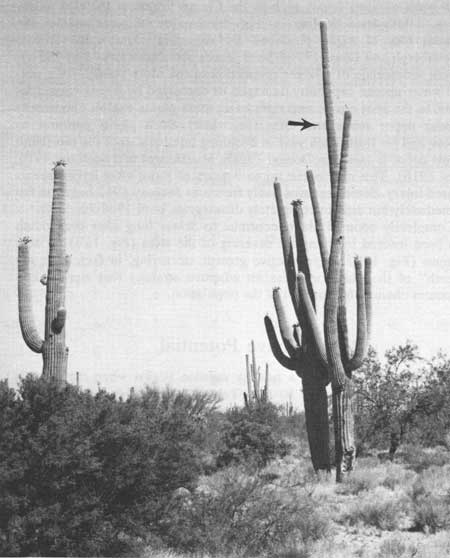|
SAGUARO
Ecology of the Saguaro: II NPS Scientific Monograph No. 8 |

|
CHAPTER 2:
REPRODUCTIVE GROWTH (continued)
Freeze and Drought Limitations
Reproductive growth occurs during the driest period of the year, and is supported by energy derived from succulent stem tissues (Lloyd 1907; Fig. 13B). Extreme drought conditions during winter and spring appear to have little or no diminishing effect upon reproductive growth (Thackery and Leding 1929). Thus, regardless of year-to-year variations in rainfall, the saguaro produces an annual crop of seeds.

|
|
Fig. 13B. Reproductive growth of a
"dead" saguaro completely severed from its roots by lightning in early
September 1969. The undamaged upper portion of the stem produced buds
(arrow) and flowers during the spring of 1970, and again in
1971. Energy for reproductive growth derived succulent stem tissues allows flower and fruit production to proceed independently of year-to-year variation in rainfall. Thus, an annual crop of saguaro seeds is guaranteed even following a year or more of extreme drought. Photographed 13 May 1971. |
Winter freeze-caused injuries can effect a drastic reduction in the current year's fruit production. Subsequent to severe freezes in January 1962 and in 1971, most reproductive saguaros in the Tucson area exhibited abnormal fruiting patterns and diminished production of fruits. Normally productive areas of stem and arm tips, often showing no evident signs of injury, failed to produce fruits (Fig. 14A; Table 2).

|
|
Fig. 14A. The effect of freeze-caused
injury on saguaro fruit development at Saguaro National Monument (east).
Compare with the normal plant shown in Fig. 13A. The normally productive barren area of the crown separating the two clusters of fruit on this 4.5-m (14.8-ft) plant is a result of freeze-caused injury recieved the previous January. In 1970, a year without critical freezing conditions, 201 fruits were present on this plant in 25 June. On the same date in 1971, 46 fruits were present (Table 2). Most other adult saguaros in the Tucson area were similarly affected. Along the cold-limited northeastern boundary of its range, saguaro seed production is significantly reduced during years when catastrophic freezes occur. Photographed 25 June 1971. |
| Plant no. |
1970 Stem height (cm) |
Matured fruits |
% Decrease | |
| 1970 | 1971 | |||
| 69B | 441 | 201 | 46 | 77.1 |
| 69D | 461 | 141 | 28 | 80.1 |
| Total | 902 | 342 | 74 | --- |
| Mean | 451 | 171 | 37 | 78.4 |
We estimate that in the Tucson-area in southeastern Arizona, January freeze-caused injury reduced the 1971 seed crop to less than 20% of that for the previous year (Fig. 14A). To a lesser degree the 1971 injuries also reduced fruit production in 1972, when permanent injuries were evidenced by barren and sometimes scarred areas on arm and stem tips (Table 3).
| Saguaro | 1969 | 1970 | 1971 | 1973 |
| 69A | 73 | -- | 6 | 11 |
| 69B | 100 | 169 | 46 | 55 |
| 69C | 76 | -- | 68 | 91 |
| 69D | 40 | 112 | 28 | 97 |
In some saguaro stands such as the Cactus Forest of the east monument, a long-term decline in reproductive growth accompanies the general loss of vigor produced by recurring catastrophic freezes (Steenbergh and Lowe 1976). Such stands are characterized by the apparent senescence of a larger proportion of the older plants. Their normal water-uptake capability damaged or destroyed by freeze-caused injuries to the root crown and stem base, these plants exhibit abnormally slender upper stems and arms (Fig. 14B). Such plants continue to bloom and set fruits each year in declining numbers, until the moribund plants collapse (see MacDougal 1908b; MacDougal and Spalding 1910; Pool 1916). This may occur up to 9 years or more after lethal freeze-caused injury. Some saguaros badly frozen in January 1962 began to fail immediately but did not completely disintegrate until 1968-70.

|
|
Fig. 14B. Reproductive growth of a
senescent saguaro (arrow). The slender plant on the right (ht 12 m; 39.4
ft) bears two buds, ten flowers, and two well-developed fruits. Compare
with the healthy saguaro at far left. A common sight in Saguaro National Monument, the shriveled upper stem and arms that indicate a senescent condition are the delayed result of lethal freeze-caused injury—the plant is dead. Water uptake capability has been destroyed by freeze-caused internal damage to the lower stem. Long pre-existence of that condition (more than one year) is evidenced by the severely withered condition of the upper stem and arms which after the injury have continued to provide energy for reproductive growth. The ability to continue seed production for one or more years after the occurrence of a lethal freeze provides an added survival potential for populations along the cold-limited northern and eastern margins of the species range. Photographed 6 June 1973. |
Completely doomed plants continue to flower long after their death has been insured by complete severing of the stem (Fig. 13B) or stem systems (Fig. 14B). Reproductive growth, occurring, in fact, after the "death" of the plant, involves an adaptive strategy that significantly enhances chances for survival of the population.
| <<< Previous | <<< Contents >>> | Next >>> |
chap2a.htm
Last Updated: 21-Oct-2005